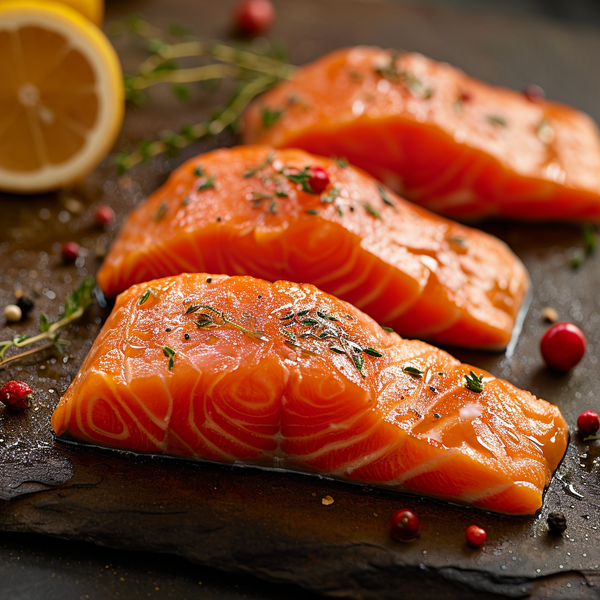
Salmon
Salmon is a versatile and popular fish in culinary circles, known for its rich flavor, high omega-3 fatty acid content, and tender, flaky texture. It can be prepared using various cooking methods and is featured in numerous cuisine styles around the world. Here's how salmon is commonly used in cooking:
Grilled Salmon:
Grilling imparts a smoky flavor to salmon, and the high heat creates a crispy exterior while keeping the interior moist. Salmon fillets, steaks, or whole sides can be grilled, often with a marinade or simple seasoning.
Baked or Roasted Salmon:
Baking or roasting salmon in the oven is a simple, healthy preparation method. It can be seasoned with herbs, spices, and lemon, or topped with sauces or glazes, such as maple or mustard.
Pan-Seared or Pan-Fried Salmon:
Pan-searing or frying gives salmon a crispy skin and golden crust. It's typically cooked skin-side down first to render the fat and crisp the skin, then finished on the other side.
Poached Salmon:
Poaching in a liquid such as water, wine, or broth results in a tender, moist texture. Poached salmon can be served hot or cold and is often accompanied by sauces like hollandaise or dill.
Smoked Salmon:
Salmon is cured and then cold-smoked to impart a delicate smoky flavor. Smoked salmon is a staple in dishes like bagels with cream cheese, in canapés, or added to salads and pasta.
Cured Salmon (Gravlax):
Salmon is cured with salt, sugar, and dill to create gravlax, a Scandinavian specialty. It's typically served thinly sliced with mustard sauce, on bread, or with blinis.
Salmon Sashimi and Sushi:
In Japanese cuisine, raw salmon is used in sashimi and sushi, valued for its rich flavor and buttery texture. It's often served with soy sauce, wasabi, and pickled ginger.
Salmon Cakes or Burgers:
Cooked or canned salmon can be mixed with binders like breadcrumbs and eggs and formed into cakes or burgers, then pan-fried. They're often served with remoulade or tartar sauce.
Salmon Pasta and Risotto:
Flaked cooked salmon or smoked salmon can be added to pasta dishes and risottos, contributing a rich, savory flavor that pairs well with creamy sauces.
Salads:
Both cooked and canned salmon are used in salads, ranging from simple green salads to more substantial options like Niçoise or potato salad.
When cooking salmon, it's important to consider its fat content and how it affects cooking times and methods. Fattier salmon like King (Chinook) can withstand higher heat and longer cooking times, while leaner varieties like Sockeye may dry out if overcooked. The skin can be left on during cooking to help keep the fish moist and to add texture. Salmon's popularity is due in part to its health benefits, including high protein content and omega-3 fatty acids, making it a nutritious choice for meals.
Nutritional Information
calories
146
carbohydrates
0 g
fats
5.93 g
protein
21.62 g